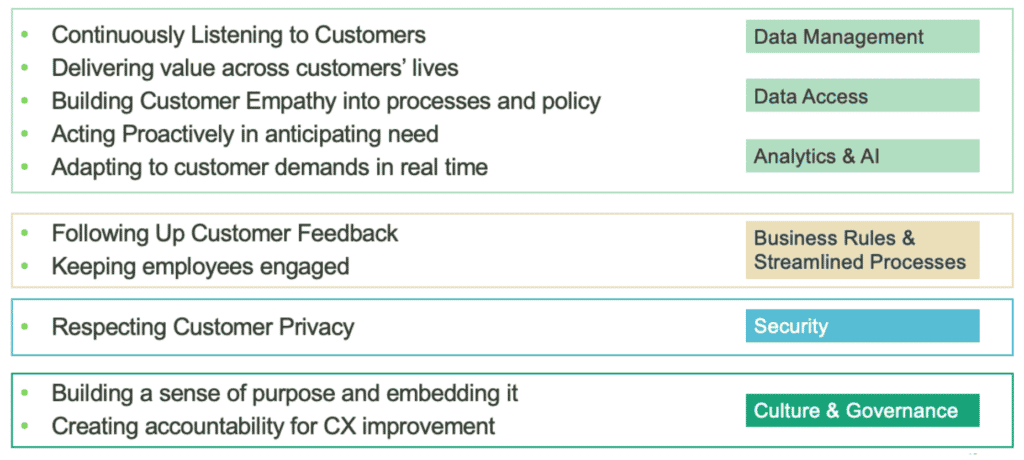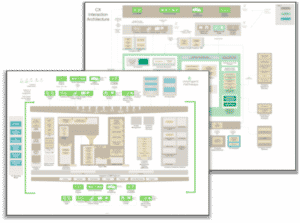Organisations across all industries are grappling with changes to customer relationships as the physical and digital worlds converge. Many businesses are beginning to look to their students, patients, passengers, clients, citizens and tenants as customers in the more traditional sense, and are racing to keep up with growing expectations for end-to-end customer experience.
Organisations are therefore looking to customer centricity initiatives to support this end-to-end experience with either their existing or new technology landscapes. But this can prove more challenging than expected, due to increasing numbers of data points/sources, channels, technologies and integration complexity.
In this blog I’ll explore the idea of customer centricity as it fits in the context of enterprise technology, and consider what steps architects and IT leaders need to go through to begin developing an architectural approach to support an overarching customer centric business strategy.
What is Customer Centricity?
Gartner defines Customer Centricity as “the ability of people in an organisation to understand customers’ situations, perceptions, and expectations.” The ‘people’ in this context are not just the ‘frontline’, but all staff who participate in processes or produce something that contributes to an interaction with a customer. The mindset change is significant, from thinking about what we are doing ‘at them’ (targeting, selling, delivering, supporting), to what they are experiencing through their customer lifecycle (becoming aware, researching, deciding, purchasing, consuming).
And this is just for one transaction! When we aim to shift the engagement from transactional to relational (whole-of-life customer journeys) the data points grow exponentially, as does the potential to derive insights and determine ‘next best actions’. We can then begin to treat customer data not only through a privacy and security lens, but as an asset class with significant intrinsic and monetary value.
Though this shift in thinking can be challenging for architects and IT leaders, it is a necessary first step. Only by aligning the broader business goals with technology decisions will the business be able to execute a streamlined customer experience and reap the rewards.
Translating Customer Centric Principles
In order to better understand how the IT leader’s architectural response to customer centricity should work, it is worthwhile comparing Gartner’s 10 habits of Customer-Centric Organisations with their equivalent IT competencies and disciplines, as seen in the table below. These are not comprehensive, but do help to illustrate the disciplines that need to be leveraged and enhanced to serve the strategy, and bring the conversation back into familiar territory.
Again, the shift in language is challenging – Listening? Empathy? Anticipation? But it’s a deliberate shift from knowing what we provide (We’ll build it) to understanding what they need (Will they come?).
The key takeaways from these habits are:
- Data types and sources will increase exponentially, both from within and outside your organisation
- A shift towards unconstrained analytics is required to accommodate adaptive needs and fluid data
- End-to-end process understanding should not be undervalued
- The customer needs to be in the loop, not at the end of the chain
Identifying Technologies that Enable Customer Centricity
Once technology leaders are familiar with the language of customer centricity & experience and how it interacts with the technology domain, we can turn to technical and architectural considerations.
Here we face challenges mainly around complexity and variety; in order to manage the end-to-end experience of the customer you need an understanding of all the technologies/systems that currently (and might later) enable it. And to make the task a harder one, a wide range of technologies exist both in the market and within most businesses. This is the reason scope is often the first challenge in many customer centricity or CX projects.
Such a varied collection of technologies can also easily lead to fragmentation and siloed systems without a cohesive architectural approach to their adoption. Digital leaders and architects need to take care to set out a roadmap that delivers on this outcome, whilst ensuring good governance principles are leveraged. There is tremendous opportunity in ensuring that data from these multiple threads of engagement can be woven together to derive new insights, new reasons to engage, and ultimately improve value for the customer.
Key questions and considerations for mapping out a customer centric technology ecosystem include:
- How much of the customer journey is currently served by existing technologies, and how well?
- What new investments are needed to serve new and existing customer needs?
- What format will new investments take? Domain specific SaaS solutions can help solve large amounts of the customer journey, but it is important to understand that no one customer centricity solution will ever serve the full journey, despite what vendors may promise.
- Which systems need to interact with each other to enable a streamlined journey, and how do you approach the integration architecture? This is a step that is often overlooked in large projects, and subsequently causes delays and increased costs.
Aligning Customer Centricity with Technology
The CX technology ecosystem is extremely broad, so it can help to see an example of how this all fits into place. We have an architectural blueprint (CX Technology Ecosystem) available for download here, that sets out all these disciplines and how they work together in a customer centric technology ecosystem. This includes multiple channels and shows the data flow throughout sales, marketing and operational systems within the organisation, and is a valuable lens for key organisational stakeholders to plan their capability roadmap.
Remember that it is also critical to consider how both new and existing systems will interact with one another; a cohesive integration approach can make or break end-to-end customer processes and have a huge impact on any new implementations. See an example CX Integration Architecture here that shows the existing and planned integrations over the example organisation’s customer experience technology ecosystem.
Combined with a strong understanding of your unique business goals for customer centricity, these architecture artefacts help capture the interrelatedness and fluidity of customer experiences, and arm architects with the structure and perspective needed to support a customer-centric strategy.





